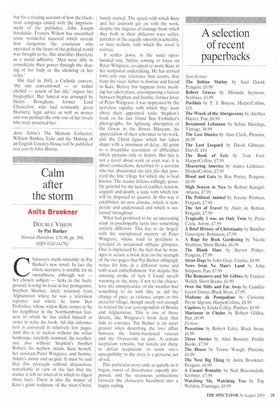Calm after the storm
Anita Brookner
DOUBLE VISION by Pat Barker Hamish Hamilton, £16.99, pp. 308, ISBN 0241141761 Characters mesh smoothly in Pat Barker's new novel. In fact the whole narrative is notable for its smoothness, although war — her chosen subject — lurks in the background, leaving its trace in her protagonist, Stephen Sharkey, lately returned from Afghanistan where he was a television reporter and where he knew Ben Frobisher, whose widow Kate comes to be his neighbour in the Northumbrian fastness to which he has exiled himself in order to write his book. All this information is conveyed in relatively few pages. And this is to reckon without the wider landscape, carefully itemised, the weather, and also without Stephen's brother Robert, his nephew Adam, Kate herself, her assistant Peter Wingrave, and Justine, Adam's nanny and au pair. It must be said that this proceeds without disjunction, remarkable in view of the fact that the reader is left no interval in which to digest these facts. There is also the matter of Kate's giant sculpture of the risen Christ,
barely started. The speed with which Kate and her assistant get on with the work, despite the degrees of damage from which they both in their different ways suffer, partakes of the equally smooth practicality, or near realism, with which the novel is written.
It settles down, in the same openhanded way, before coming to focus on Peter Wingrave, co-opted to assist Kate in her sculptural undertaking. He has arrived with only one reference that counts, that from the vicar, father to Justine and friend to Kate. Before this happens more meshing has taken place, encompassing a liaison between Stephen and Justine, former lover of Peter Wingrave. I was impressed by the nerveless rapidity with which they went about their appointed tasks: Stephen's book on his late friend Ben Frobisher's photographs, his lightning absorption of the Goyas in the Bowes Museum, his appreciation of their relevance to his work, and the Christ figure which has taken shape with a minimum of delay. All point to a dreamlike resolution of difficulties which pertains only to fiction. But this is not a novel about work or even war: it is about connections, described by a novelist who has abandoned the idee fixe that powered the fine trilogy for which she is best known. The reader follows willingly, possibly grateful for the lack of conflict, tension, anguish and doubt, a state with which few will be disposed to quarrel. In this way it establishes its own climate, which is temperate and understated and which is sustained throughout.
What had promised to be an interesting study in psychopathy turns into something entirely different. This has to do largely with the unexplained mystery of Peter Wingrave, whose road to perdition is revealed in occasional oblique glimpses. One is impressed by the fact that he manages to secure a book deal on the strength of the two pages that Pat Barker obligingly writes for him, in a different tense and with scant embellishment. Yet despite this amazing stroke of luck I found myself warming to the story, if not to the characters: the omnipresence of the weather had something to do with this, as did the change of pace, as violence erupts in this peaceful village, though surely not enough to remind the war correspondent of Bosnia and Afghanistan. This is one of those details. like Wingrave's book deal, that fails to convince. Pat Barker is on surer ground when describing the love affair between the battle-hardened veteran and the 19-year-old au pair. A certain scepticism remains, but novels are there to defeat scepticism: to resist one's susceptibility to the story is a perverse act of will.
This particular story ends as quietly as it began, waves of disturbance expertly dispersed, and the strenuous connections between the characters becalmed into a happy ending.


























































 Previous page
Previous page